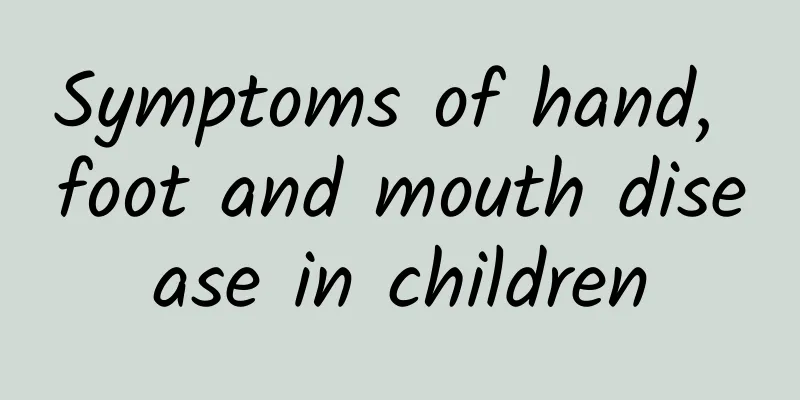Symptoms of hand, foot and mouth disease in children

|
There are many common diseases among children. When a child develops a disease, they will show obvious symptoms, usually fever and lack of energy. At this time, parents need to pay attention to their children's condition. If the disease is serious, they must be sent to the hospital for treatment in time so that the child's body will not be affected. Hand, foot and mouth disease is common in children. What are the symptoms of hand, foot and mouth disease in children? Many people are not very familiar with the symptoms of hand, foot and mouth disease in children. Therefore, before treating such a disease, it is necessary to have a good understanding of its symptoms so that you are clear about how to treat it and parents can actively cooperate in the treatment of such diseases. Symptoms of hand, foot and mouth disease in children: 1. Common symptoms Acute onset, fever, mouth pain, anorexia, scattered blisters or ulcers on the oral mucosa, mostly located on the tongue, buccal mucosa and hard forehead, and may also affect the soft palate, gums, tonsils and pharynx. Maculopapular rashes appear on the hands, feet, buttocks, arms, and legs, and later turn into herpes. There may be inflammatory red halos around the herpes, and there is less fluid in the blisters. There are more of them on the hands and feet, and on the back of the palms. The number of rashes ranges from a few to dozens. It fades away without leaving any traces or pigmentation. Some cases only present as rash or herpangina. Most patients recover within a week and the prognosis is good. In some cases, the rash may be atypical, such as appearing in a single area or only as maculopapular rash. 2. Symptoms of severe cases In a few cases (especially those under 3 years old), the disease progresses rapidly, with meningitis, encephalitis (brainstem encephalitis is the most dangerous), encephalomyelitis, pulmonary edema, circulatory disorders, etc. occurring within 1 to 5 days of onset. In very rare cases, the condition is critical and can lead to death, and survivors may have sequelae. (1) Neurological manifestations when concurrent central nervous system diseases occur: poor spirits, drowsiness, irritability, headache, vomiting, delirium or even coma; limb tremors, myoclonus, nystagmus, ataxia, eye movement disorders; weakness or acute flaccid paralysis; convulsions. Physical examination revealed signs of meningeal irritation, weakened or absent tendon reflexes, and a positive Babinski sign. Central nervous system symptoms are more common in children under 2 years old. (2) Respiratory system manifestations of pulmonary edema: shallow breathing, difficulty breathing or change in rhythm, cyanosis of the lips, cough, coughing up white, pink or bloody foamy sputum; moist rales or sputum sounds can be heard in the lungs. (3) Circulatory system manifestations of concurrent myocarditis: pale complexion, skin patterns, cold limbs, cyanosis of fingers and toes, cold sweats, and prolonged capillary refill time. The heart rate increases or decreases, the pulse becomes shallow or weak or even disappears; the blood pressure increases or decreases. Through the above introduction, we have a good understanding of the symptoms of hand, foot and mouth disease in children. Therefore, when treating such a disease, we must have a good understanding of these symptoms. However, when treating hand, foot and mouth disease in children, medication is a common method. This type of treatment is very helpful in improving children's disease. |
<<: What to do if you have habitual dislocation
Recommend
What kind of body type is it if the whole body is cold in summer?
In the summer, if your whole body is cold, you mu...
What causes toe pain?
Toe pain is a phenomenon that many people experie...
What to do with tonsil ulcers? Six ways to tell you
Tonsils Tonsillar ulcers are also called adenoid ...
How to quickly reduce swelling of the tooth
Tooth pain can be quickly relieved by taking anti...
What should I do if my tonsils are festering?
Tonsillar suppuration is actually quite serious, ...
What to do if your lungs are blocked
Pulmonary obstruction, also known as obstructive ...
What is gastric triple therapy?
Gastrointestinal diseases are usually caused by H...
What to do about headache caused by cervical belt?
In life, many people like to watch mobile phones ...
How to prepare for a colonoscopy?
Intestinal health is something people need to pay...
What causes burning sensation in the calves
Some people often feel a burning sensation in the...
What is the good Chinese medicine remedy for spontaneous sweating and night sweats?
It is normal for people to sweat when it is hot. ...
What is the traditional Chinese medicine prescription for lung heat cough?
I don’t know if you have ever heard of the diseas...
Why do I feel weak?
If you feel weak at ordinary times, it may be rel...
What to do if you have arrhythmia? Expert recommended treatment
Arrhythmia is a type of heart disease. Arrhythmia...
Can I drink milk after double eyelid surgery?
You can drink milk after double eyelid surgery. W...









